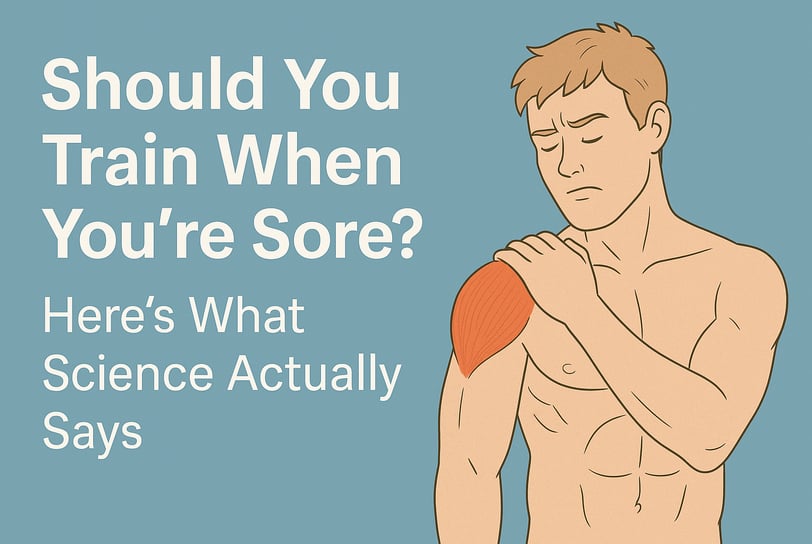Should You Train While Sore? What the Science Says About Recovery, Performance & Risk
Wondering if it’s safe to train while sore? Learn the real science behind muscle recovery, when to rest, and how to bounce back faster with expert tips and top recovery tools.
5/27/20253 min read


Should You Train When You’re Sore? Here’s What Science Actually Says
We've all been there. You crushed a workout, woke up the next morning feeling like you got hit by a truck, and now you're wondering—should I train again, or should I rest? Social media’s full of hot takes, but the real answer depends on what kind of soreness you’re feeling, why you’re sore, and what your goals are.
So let’s break it down. No hype. No fluff. Just straight recovery science and practical advice.
What Is Muscle Soreness, Really?
The kind of soreness most lifters, athletes, and weekend warriors feel after a tough session is called DOMS—Delayed Onset Muscle Soreness. It usually hits 12–48 hours post-workout, especially after eccentric movements (think lowering a squat or the negative portion of a pull-up).
DOMS happens because your muscles experience microtears during hard training. That’s not a bad thing—in fact, it’s part of the adaptation process. The muscle rebuilds stronger after. But when the damage is too much or recovery is lacking, it can spiral into fatigue, poor performance, and even injury risk.
A 2022 review in Sports Medicine confirmed that DOMS peaks at 24–72 hours post-training and is not correlated with muscle growth—meaning feeling sore doesn’t mean your workout was “better.”
So… Should You Train or Not?
Here’s the honest breakdown:
You CAN train when sore IF:
The soreness is mild to moderate (1–5 on a 10 scale)
You still have full range of motion
You’re targeting different muscles than the sore area
You use it as an active recovery day (light cardio, stretching, blood flow work)
You SHOULD rest if:
The soreness is severe or sharp
You feel tight, stiff, or restricted
You’re unable to move or lift with proper form
Your sleep, energy, or appetite are suffering
The key is listening to your body, not your ego. If your soreness makes you move differently or compensate, you’re just increasing your injury risk.
What to Do When You’re Sore: Real Recovery Tactics
Most people assume soreness means they need to pop ibuprofen and wait it out. But science says otherwise. Research shows that low-intensity movement and circulation work actually speed up recovery.
Here’s how to bounce back smarter:
Light Cardio (10–20 min): Increases blood flow to bring nutrients to damaged muscles.
Contrast Showers: Switching between hot and cold water improves circulation and reduces inflammation.
Stretching + Mobility: Keeps the joints moving and helps flush out waste metabolites.
Massage + Vibration Therapy: Studies (like this 2017 systematic review) show vibration therapy can reduce soreness and improve flexibility post-workout.
Product we recommned: Deep Tissue Recovery for Sore Days
PSO-STICK Combo – Amazon
This tool is built to dig deep into quads, hamstrings, and calves—perfect when soreness hits hard.
Why it works: Mimics deep tissue massage. Helps flush out lactic acid and break up knots without needing a partner.
Use it for: Rolling out sore legs, glutes, or shoulders pre- and post-training.
Should You “Push Through” It?
Here’s where most people mess up: they assume soreness is a badge of honor. But pushing through high soreness days with high intensity actually delays your progress.
Training through mild soreness with lower intensity or reduced volume? Totally fine. But trying to PR your squat when your glutes are torched? That’s asking for a setback.
A great rule of thumb:
Train around soreness, not through it.
Shift from load-based goals (e.g., heavy weights) to movement-based goals (e.g., quality, range of motion, tempo). That keeps recovery rolling without stalling progress.
Product we recommend: Heated Vibration Ball for Fast Relief
MyoStorm Mini Meteor – Amazon
A small but powerful recovery ball that combines heat and vibration to go deep into tissue.
Why it works: Research shows heat + vibration improves muscle elasticity and decreases perceived soreness faster than static tools.
Use it for: Sore traps, hips, back, or feet. Perfect for pre-bed recovery routines.
Nutrition’s Role in Recovery (Yes, It Matters)
Training while sore is only part of the picture. If you’re not eating and hydrating properly, even the best recovery routines won’t work.
Protein intake: Aim for 0.7–1g per lb of body weight to support muscle repair.
Anti-inflammatory foods: Tart cherry juice, turmeric, ginger, omega-3s (from fatty fish or flax).
Hydration: Electrolytes matter. Dehydration worsens soreness and slows recovery.
Fun fact: A 2021 study in Nutrients found that tart cherry juice significantly reduced muscle soreness and inflammation markers in strength athletes.
Product we recommend: Tart Cherry Recovery Chews
Tart Cherry Extract Gummies – Amazon
Simple and effective recovery snack with a clean ingredient list.
Why it works: Rich in anthocyanins, which reduce inflammation and soreness post-exercise.
Use it for: Pre-bed or post-training snack to speed up recovery naturally.
Final Word: Train Smart, Not Stubborn
Soreness is a signal, not a stop sign—but it’s also not something to ignore. Learn to work with your body, not against it.
If you're mildly sore, keep moving. If you’re wrecked, recover properly. The smartest athletes aren’t the ones who train the hardest—they’re the ones who recover the best.
FITNESS
Nutrition
WellnesS
info@movebetterco.com
© 2025. All rights reserved | Privacy Policy | Terms & Conditions